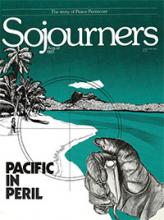On March 1, 1954, at 6:45 a.m., the U.S. government detonated a 15-megaton hydrogen bomb in the Bikini Atoll. Within a few hours, the ash-like radioactive fallout from the "Bravo" test explosion began to descend on the nearby inhabited atolls of Rongelap and Rongerik. An air force witness said the fallout resembled "a snowstorm in the middle of the Pacific."
A two-inch-deep layer of radioactive dust accumulated on Rongelap, contaminating its food supply and drinking water. Children playing in the powder experienced skin eruptions on their arms and faces. By the end of the day, the residents of Rongelap had begun to exhibit the symptoms of acute radiation exposure: burns, severe vomiting, diarrhea, and hair loss.
The islanders were not evacuated from Rongelap until two days after the blast. They and other Marshallese people have suffered the insidious long-term effects of radiation exposure because of the contamination of their land and the cumulative effects of radiation on their bodies. For example, the rate of stillbirths and miscarriages among Rongelap women who were exposed to the fallout rose to more than twice the rate in unexposed Marshallese women for the four years following the Bravo detonation.
In 1957, the Rongelap Atoll was declared safe for habitation, despite "slight lingering radioactivity," and the people returned home. The radioactivity in the bodies of the Rongelap people increased rapidly as they lived on their island and ate the food raised there. By 1958 the amount of radioactive cesium, a carcinogen that accumulates in muscle tissue, had increased 60-fold. The amount of radioactive strontium, which concentrates in bones and can cause bone cancer or leukemia, increased 20-fold in the same period. Cancers resulting from radiation take years to develop and the full impact of the contamination cannot yet be estimated.
Read the Full Article

